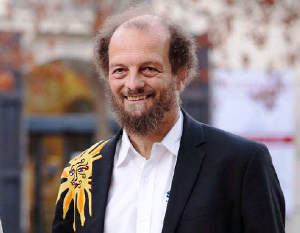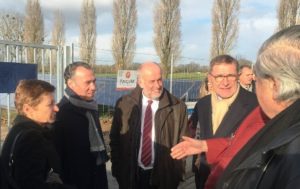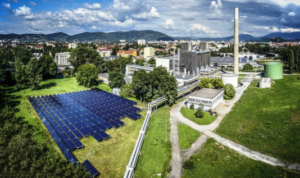Operators of several gas-driven combined cycle power plants, or CCPPs, have notified the German Federal Network Agency of their systems’ final shutdown. These plants are no longer economically viable, as they have been running ever fewer hours because of a high proportion of cost-effective renewable grid electricity. Their shutdown will create a shortage of supply in district heating networks providing thermal energy to German municipalities. Utility-scale solar thermal plants equipped with seasonal storage could help close the gap at heat prices of around 36 EUR/MWh, Christian Holter said. Holter is the Managing Director of Austrian turnkey system supplier S.O.L.I.D., which has carried out feasibility studies on behalf of several European cities.
Solarthermalworld.org: 36 EUR/MWh is a record-low heat price. What does it include?
Holter: It is a reseller price which combines the capital expenditure (CAPEX) on the entire installation, including seasonal storage, management and financing, and O&M expenses during the duration of the project. In this case, we are talking about full costing over 25 years in total. The heat price of 36 EUR/MWh is an average between 31.7 EUR/MWh and 40.6 EUR/MWh depending on the type of financing (see the table below). In our calculations, we have used a minimum collector field capacity of 70 MW and set the supply temperature of seasonal storage and heat pumps to 85 °C. If the temperature needs to be higher, you can add a second series of heat pumps or boilers.
Solarthermalworld.org: Is this price comparable to the record low electricity prices that have recently shown up on multiple tenders by turnkey photovoltaic suppliers around the world?
Holter: There is a big difference to these record-low electricity prices, because the energy priced at 36 EUR/MWh has a much higher level of quality. When you carry out a financial analysis for a grid-connected PV plant, the cost of demand side management to stabilise the grid is outside the scope of your project. This is the opposite of what we are offering municipalities which shut down their CCPP systems. They will get a solar heat supply system which has been configured to meet annual heat demand and will supply a significant proportion of space heating in winter via seasonal storage.
Solarthermalworld.org: Can you quantify the demand side share of the heat price?
Holter: The feasibility studies which we conducted on behalf of municipal utilities have shown energy production to make up around two-thirds of the heat price, about 22 EUR/MWh. The remaining one-third is associated with seasonal storage and energy management.
|
Specific system costs, excl. subsidy
[EUR/m²]
|
Type of financing
|
LCOH over 20 years
[EUR/MWh]
|
LCOH over 25 years
[EUR/MWh]
|
LCOH over 30 years
[EUR/MWh]
|
|
70 MW collector field with 430,000 m³ seasonal storage
|
375
|
Low-interest infrastructure loan at 1 %
|
38.0
|
31.7
|
27.5
|
|
375
|
20 % equity at 8 % plus 80 % loaned at 3.5 %
|
46.8
|
40.6
|
36.6
|
|
70 MW collector field without seasonal storage
|
222
|
Low-interest infrastructure loan at 1 %
|
23.3
|
19.6
|
17.1
|
|
222
|
20 % equity at 8 % plus 80 % loaned at 3.5 %
|
28.5
|
24.8
|
22.5
|
Levelised Cost of Heat (LCOH) for different finance options and project lengths. Investment costs are 110 % of technical CAPEX. Both scenarios include a 15 % grant. Annual solar heat production amounts to 50,000 MWh.
Source: S.O.L.I.D.
Solarthermalworld.org: What is the difference between investment costs and CAPEX in your feasibility studies?
Holter: What we typically call technical CAPEX comprises all costs related to the purchase and installation of a turnkey solar heat plant, including the collector field, storage, pipes, heat transfer units, monitoring devices, mounting system and transport. To arrive at total CAPEX costs, you need to take into account project management fees, which add between 5 % and 10 % to the technical CAPEX of projects with a contract value of between EUR 2 million and EUR 20 million. Likewise, you need to add another 5 to 10 % to the investment costs to secure financing. In all, full CAPEX costs will be around 110 % to 120 % of the technical CAPEX.
Solarthermalworld.org: The amount of CAPEX or full costs (including OPEX) is still a relatively easy-to-understand and comparable figure. But when we get to the point of dynamic financial analysis, will results not differ significantly from each other?
Holter: That is correct. The cost of financing has significant influence on solar heat prices. We have had solar district heating projects for which the client sought an 8 % return on equity over 20 years. In this example, the average solar heat cost (LCOH) of a 70 MW collector field is between 28.5 EUR/MWh, if the system has daily storage, and 46.8 EUR/MWh, if it includes seasonal storage (see italic figures in the table above).
On the other hand, a utility could view the solar heat plant as a 25-year infrastructure investment. Then, a municipal utility, whose credit rating is usually well above average, could obtain a loan at an interest rate as low as 1 %. This sort of deal would mean a significant reduction in the average solar heat price to 19.6 EUR/MWh, if there is a daily storage system, or 31.7 EUR/MWh, including seasonal storage (see black bold figures in the table above). The technical life of the plant and its components will be at least 25 years.
Solarthermalworld.org: Which method do you use to calculate average solar heat prices?
Holter: The levelised cost of heat is the average cost for generating 1 MWh of heat during the duration of a project. This means that the LCOH is the price you charge for 1 MWh throughout the heat generating project to recover full costs.
Usually, the LCOH is used to compare different types of heat generation and investment. However, there is little transparency on the district heating market. It is hard to find publications which include the LCOH based on the full costs of gas boilers or CCPP plants. We know that utility gas prices are around 23 to 27 EUR/MWh, but these prices include neither the investment nor operating expenses of the boiler or CCPP unit. The current full costs of generating heat via gas boiler range between 28 and 35 EUR/MWh, but no one knows how fossil fuel prices will develop over time.
Solarthermalworld.org: How do you know that the average solar heat prices listed in your feasibility studies are of interest to municipal utilities in Germany?
Holter: Based on discussions with utility staff, we know that there is interest in solar heat costs below 40 EUR/MWh. These costs are comparable to the ones of other heat production sources, but even if gas prices are a bit lower right now, the solar tariff offsets the risk of increased energy costs.
Solar heat prices are entirely independent of fossil fuel price fluctuations, as sunlight is for free. I see large economic and social benefits coming. The long-term competitiveness of solar district heating is guaranteed.
Interview by Bärbel Epp
More information:



